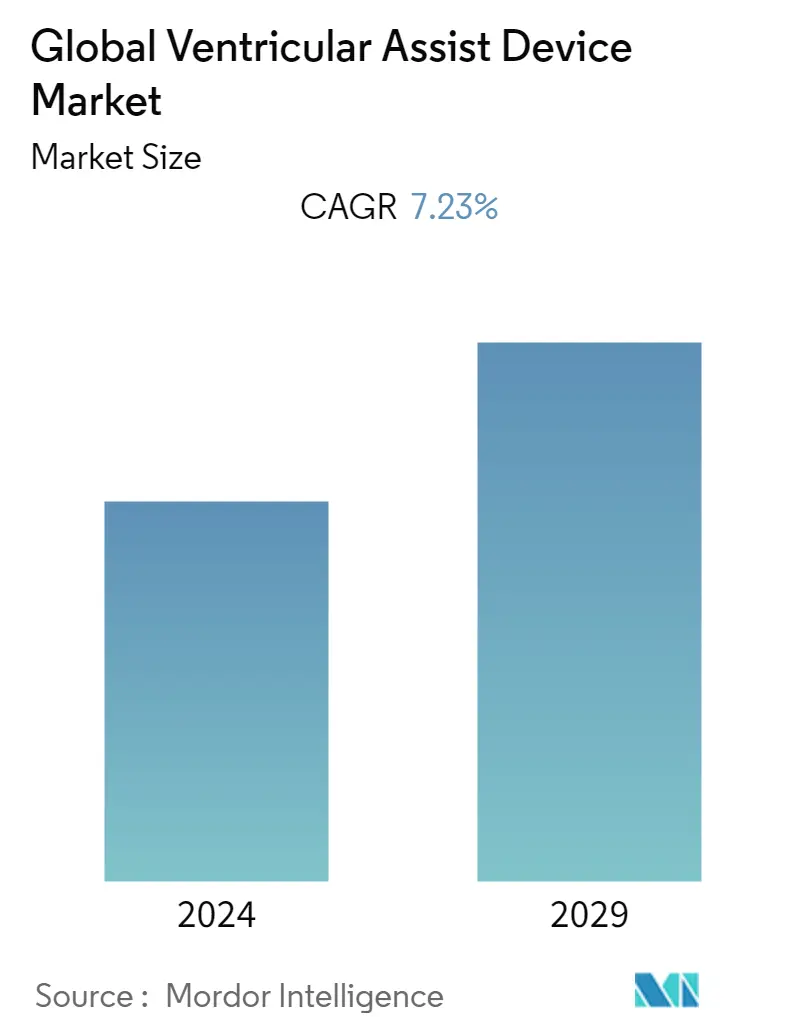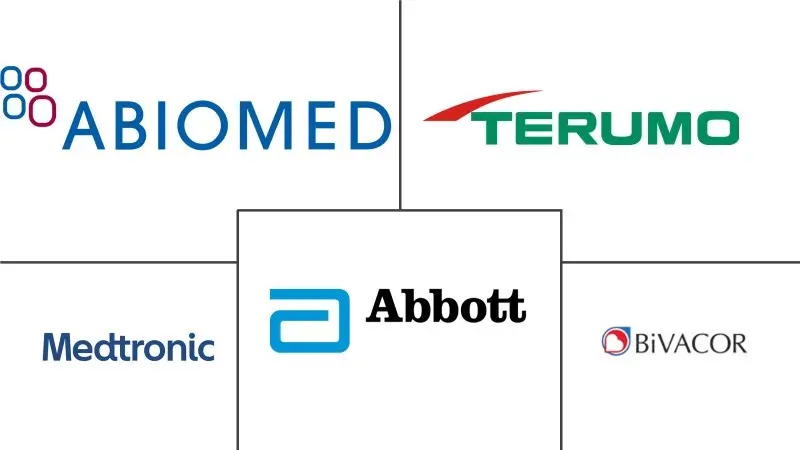Market Size of Global Ventricular Assist Device Industry

| Study Period | 2019 - 2029 |
| Base Year For Estimation | 2023 |
| Forecast Data Period | 2024 - 2029 |
| CAGR | 7.23 % |
| Fastest Growing Market | Asia Pacific |
| Largest Market | North America |
Major Players
*Disclaimer: Major Players sorted in no particular order |
Ventricular Assist Device Market Analysis
The Ventricular Assist Devices Market is poised to grow at a CAGR of 7.23% during the forecast period (2022-2027).
COVID-19 is expected to have a significant impact on the growth of the market. According to the article titled ' Implantation of Durable VAD during COVID-19: An Epicenter Experience' published in 2021 new technological advances and creativity from the team allowed for the successful implantation of urgent Destination Therapy-Ventricular Assist Devices during the COVID-19 pandemic. Hence, the onset of the pandemic allowed various modifications to the existing process which are needed to accommodate a safe and comprehensive ventricular assist device plan. Thus, the ventricular assist device market is significantly impacted by COVID-19.
The major factors attributing to the growth of the ventricular assist device market are technological advancement of devices for cardiac disease management, growing initiatives and awareness regarding cardiovascular diseases, and the increasing burden of cardiac diseases and heart failure. According to the World Health Organization 2021, an estimated 17.9 million people die due to cardiovascular diseases worldwide, each year. This represents 35% of global deaths. Additionally, 85% of these cardiovascular disease deaths are due to heart attack and stroke. In addition, according to the article published in Cureus Journal of Medical Science in July 2020, ischemic heart disease (IHD) is a leading cause of death worldwide. Ischemic heart disease affects around 126 million individuals (1,655 per 100,000) globally, which is approximately 1.72% of the world's population. The global prevalence of ischemic heart disease is expected to exceed 1,845 per 100,000 by the year 2030.
VAD implantations are lifesaving equipment for patients with severe heart failure. They are useful in minimizing the symptoms of heart failure, thus helping patients to resume their daily activities. Coronary heart diseases associated with hypertension are a very common cause of chronic heart failure. Apart from that, other cardiac conditions, such as ischaemic and dilated cardiomyopathies, also require a significant level of surgical interventions. For all patient cases requiring advanced heart failure-related therapy, heart transplantation is a long-term successful procedure.
However, due to less availability of organs, the waiting time is more than six months. Such cases require the immediate assistance of VAD, which acts as a bridge to transplantation. Here, the demand for, and availability of, VAD plays a critical role, and thus, the growing burden of cardiac diseases and heart failure is a major force in propelling the VAD market at the global level. However, there are also risks involved in the VAD implant, hence these risks are showing an impact on the market growth.
Ventricular Assist Device Industry Segmentation
As per the scope, ventricular assist devices (VAD) are highly important for patients with weakened hearts or heart failures. They are used to temporarily maintain the heart function, until the heart recovers, or before the heart transplant. In some chronic heart conditions, they are used as permanent support therapy, as they are mechanical pumps that are surgically implanted in the heart to pump blood into the whole body. The Ventricular Assist Device Market is segmented by Type of Ventricular Device (Left Ventricular Assist Device (LVAD), Right Ventricular Assist Device (RVAD), Biventricular Assist Device (BIVAD)), Application (Bridge-to-transplant (BTT) therapy, Destination therapy, and Other Therapies), and Geography (North America, Europe, Asia-Pacific, Middle East & Africa, and South America). The market report also covers the estimated market sizes and trends for 17 different countries across major regions, globally. The report offers the value (in USD million) for the above segments.
| By Type of Ventricular Device | |
| Left Ventricular Assist Device (LVAD) | |
| Right Ventricular Assist Device (RVAD) | |
| Biventricular Assist Device (BIVAD) |
| By Application | |
| Bridge-to-transplant (BTT) Therapy | |
| Destination Therapy | |
| Other Therapies |
| Geography | ||||||||
| ||||||||
| ||||||||
| ||||||||
| ||||||||
|
Global Ventricular Assist Device Market Size Summary
The ventricular assist devices (VAD) market is experiencing significant growth, driven by technological advancements in cardiac disease management and increasing awareness of cardiovascular diseases. The market is influenced by the rising prevalence of cardiac conditions, such as ischemic heart disease and heart failure, which necessitate the use of VADs as lifesaving interventions. These devices serve as critical support for patients awaiting heart transplants, addressing the shortage of available organs. The COVID-19 pandemic has further impacted the market, prompting innovations in VAD implantation processes to ensure patient safety. Major players in the industry, including Abbott, Berlin Heart, and Medtronic, are actively contributing to market expansion through new product launches and regulatory approvals, such as the Breakthrough Device designation from the U.S. FDA.
North America is anticipated to lead the global VAD market, with the United States holding a significant share due to its high prevalence of cardiovascular diseases and substantial healthcare expenditure. The region's dominance is supported by ongoing initiatives to raise awareness and improve treatment options for heart conditions. The market is moderately competitive, with a few key players currently dominating, but the entry of smaller companies is expected as the demand for cardiovascular devices continues to rise. The development of advanced devices, such as the Fully Implantable Left Ventricular Assist System, and programs like Hridyantra, highlight the ongoing innovation and commitment to enhancing patient care in the field of heart failure management.
Global Ventricular Assist Device Market Size - Table of Contents
-
1. MARKET DYNAMICS
-
1.1 Market Overview
-
1.2 Market Drivers
-
1.2.1 Growing Burden of Cardiac Diseases and Heart Failure
-
1.2.2 Technological Advancement of Devices for Cardiac Diseases Management
-
1.2.3 Growing Initiatives and Awareness Regarding Cardiovascular Diseases
-
-
1.3 Market Restraints
-
1.3.1 High Cost of Devices and Procedures
-
1.3.2 Several Risks Associated to VAD Implant
-
-
1.4 Porter's Five Forces Analysis
-
1.4.1 Threat of New Entrants
-
1.4.2 Bargaining Power of Buyers/Consumers
-
1.4.3 Bargaining Power of Suppliers
-
1.4.4 Threat of Substitute Products
-
1.4.5 Intensity of Competitive Rivalry
-
-
-
2. MARKET SEGMENTATION (Market Size by Value - USD million)
-
2.1 By Type of Ventricular Device
-
2.1.1 Left Ventricular Assist Device (LVAD)
-
2.1.2 Right Ventricular Assist Device (RVAD)
-
2.1.3 Biventricular Assist Device (BIVAD)
-
-
2.2 By Application
-
2.2.1 Bridge-to-transplant (BTT) Therapy
-
2.2.2 Destination Therapy
-
2.2.3 Other Therapies
-
-
2.3 Geography
-
2.3.1 North America
-
2.3.1.1 United States
-
2.3.1.2 Canada
-
2.3.1.3 Mexico
-
-
2.3.2 Europe
-
2.3.2.1 Germany
-
2.3.2.2 United Kingdom
-
2.3.2.3 France
-
2.3.2.4 Italy
-
2.3.2.5 Spain
-
2.3.2.6 Rest of Europe
-
-
2.3.3 Asia-Pacific
-
2.3.3.1 China
-
2.3.3.2 Japan
-
2.3.3.3 India
-
2.3.3.4 Australia
-
2.3.3.5 South Korea
-
2.3.3.6 Rest of Asia-Pacific
-
-
2.3.4 Middle East & Africa
-
2.3.4.1 GCC
-
2.3.4.2 South Africa
-
2.3.4.3 Rest of Middle East & Africa
-
-
2.3.5 South America
-
2.3.5.1 Brazil
-
2.3.5.2 Argentina
-
2.3.5.3 Rest of South America
-
-
-
Global Ventricular Assist Device Market Size FAQs
What is the current Global Ventricular Assist Device Market size?
The Global Ventricular Assist Device Market is projected to register a CAGR of 7.23% during the forecast period (2024-2029)
Who are the key players in Global Ventricular Assist Device Market?
Abiomed Inc., BiVACOR Inc., Abbott Laboratories (St. Jude Medical Inc.), Medtronic PLC and Terumo Corporation are the major companies operating in the Global Ventricular Assist Device Market.

